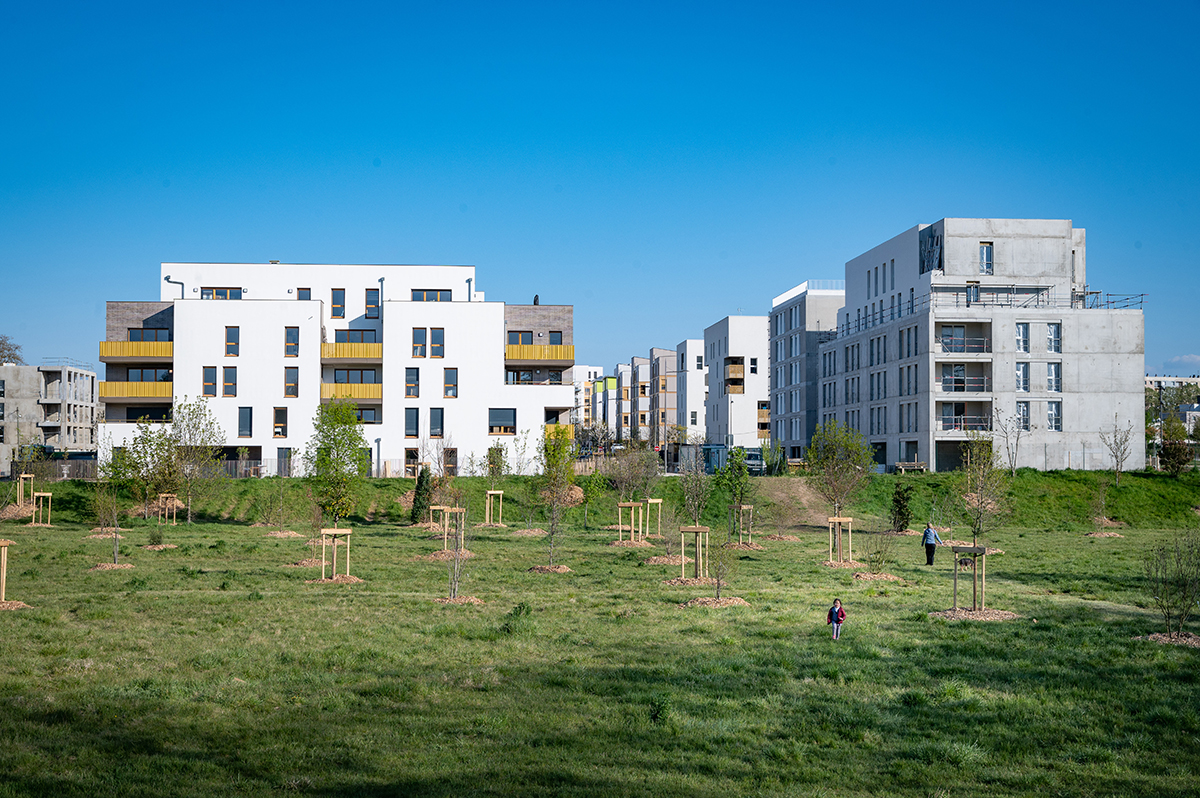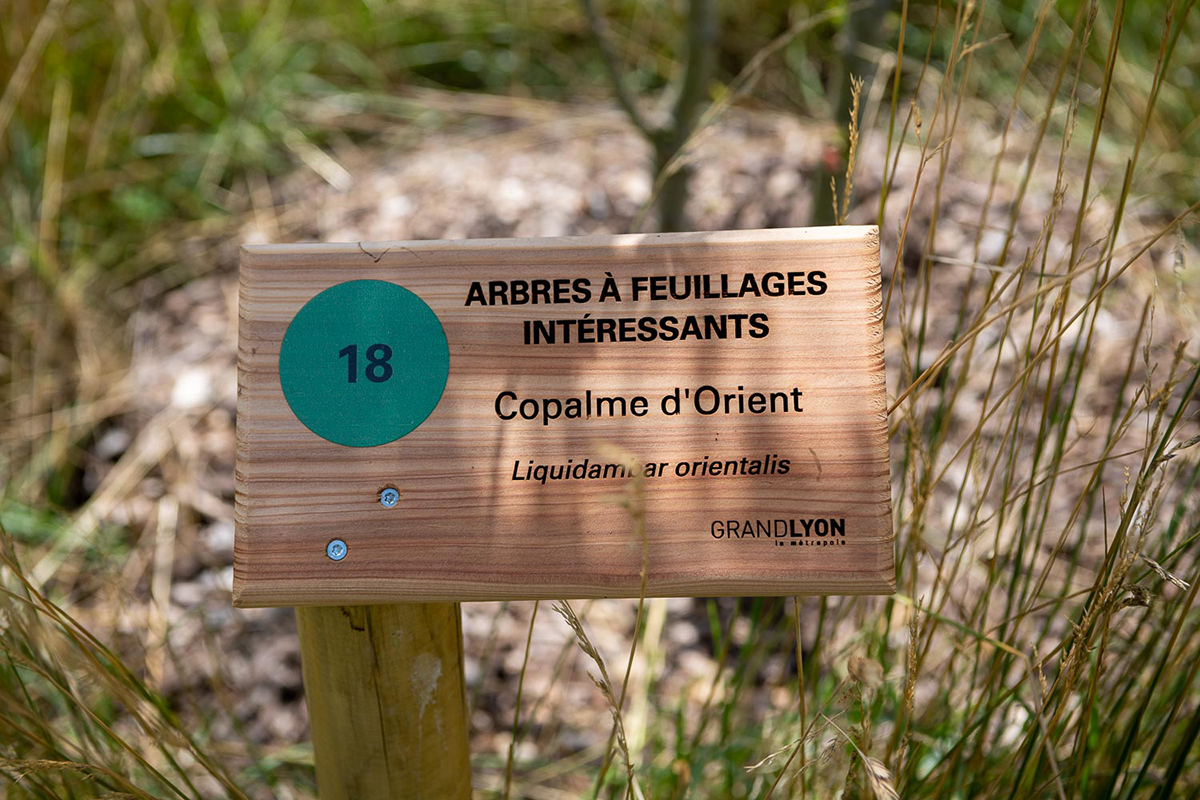Lack of plant knowledge has long been recognised as the primary obstacle to species diversification in plantings. In his 1879 treaty on The Art of Gardens, French park designer and horticulturalist Edouard André already explained: “Knowledge of tree and shrubs is so limited that nurseries focus on growing in large quantities the same species that have been grown for the past centuries, and that are always in demand. Should they wish to encourage the use of a new, little-known species, that is absolutely superior to old ones, they will find only a small number of buyers, and eventually renounce to propagate plants that they would not benefit from.”
In response, the Greater Lyon Authority has initiated the development of public arboreta hosting climate-resilient and small-growing tree species and shrubs. “Our goal with these educational arboreta is to help residents discover tree species that are adapted to the growing conditions resulting from on-going climate changes and to the limited space that often characterises private gardens in our metropolis. We wanted to create an accessible environment where we could promote these lesser-known species. The site was really more designed as a “showroom” rather than as an “arboretum” in the traditional, scientific sense of the term,” explains Frédéric Ségur who led the development of the Canopy Plan for the Greater Lyon Authority and initiated the arboreta projects.
The ambition is to invite members of the public undertaking self-build residential projects, as well as designers working on larger residential developments to draw inspiration from the species displayed in the arboreta. “Being able to see trees in-situ provides a much greater insight than just relying on any publication. Local microclimate and soils can lead to significant variations in how trees develop: the arboreta give to see how each of the selected species is likely to behave,” further explains Frédéric Ségur.
The first arboretum site was inaugurated in March 2021 in a Lyon suburb called Sathonay-Camp, where a former army base is being transformed into a new residential neighbourhood. The 1,5-hectare arboretum was created on a site that was formerly occupied by a retention basin. In addition to hosting 107 species of tree and shrub, the site also serves as local park for the 1,100 new residents immediately surrounding the project. It also hosts a large raingarden that contributes to the district-wide landscape-based sustainable drainage system managing all stormwater runoffs from the development.
Plantings within the Sathonay-Camp Arboretum are grouped according to key traits or features that are easy to recognise and relate-to for the general public. Some of the clusters focus on popular genera such as oak trees (Quercus), ash trees (Fraxinus), hackberry trees (Celtis), Lime Trees (Tilia), and maple trees (Acer). Other groupings promote genera well suited to meet widespread needs – including easy-to-care-for species for garden hedges such as privet (Ligustrum), or highlight desirable features such as “Trees with interesting foliage”, “Flowering trees” and “Fruiting trees”.
Near the site entrance, display panels provide a map and an overview of the tree collection. Visitors are also directed to an online brochure offering profile descriptions for each species. This brochure includes information on region of origin, maximum height and spread, average life expectancy and blooming season, as well as short descriptions and pictures of bark, foliage, flower and fruits, and any related notable traits.
The Greater Lyon Authority has the aspiration to develop at least one other arboretum site elsewhere in the conurbation, with a possible focus on “fruit trees”. However, finding available land for such follow-on project has proven challenging so far.
Daniel Soupe Nursery, which supplied the trees for this project, played an important role. As a long-standing signatory of the Greater Lyon’s Tree Charter, it had a very good understanding of the principle driving the management and long-term development of the Greater Lyon urban forest. An initial list of species to be featured in the arboretum was outlined by the Greater Lyon Authority’s tree services. However, final species selection came out of a dialogue with the nursery staff who had ideas on lesser-known species worth featuring in this project.
Daniel Soupe Nursery’s ability to become a strong partner for the Greater London Authority is the fruit of long-term strategic investments. Some of the choices the business made twenty years ago went against major market trend affecting the horticultural plant production sector. The “tree-production world has strongly evolved over the past two decades towards increased specialisation,” explains Benoît Blusset, commercial director at the nursery. “This leads to high fragmentation and interdependencies in the supply chain that limit our industry’s ability to adapt. You cannot really exercise control over the species you grow (let alone their provenance) if you do not have a strong hold on propagation, the first phase of the plant production process. If the right seeds aren’t seeded, there’s no chance of having the right tree available for planting…
“Since the 2003 heatwave,” further explains Benoît Blusset, “we’ve dedicated a lot of efforts towards species diversification – as opposed to adding to the existing and over-abundant range of cultivars driven by form or aesthetics. To widen our catalogues, we’ve prioritised adaptation to the growing conditions that characterise the markets we supply and the growing conditions we have. We’ve taken the time to analyse prevailing soils and anticipated climate conditions and identified where similar climate and soil constraints could be found. We’ve studied the plant palette thriving in these locations and invested significant time and energy in visiting arboretum collection as well as Victorian era parks featuring these species. This is one of the avenues we pursue for sourcing seeds allowing us to bring into cultivation species of interest. This process is more complex for exotic species. Take Quercus castaneifolia for example, which is featured in the Sathonay-Camp Arboretum. We’ve traced back primary forests growing in Azerbaijan to source our acorns! On average, every year, we introduce five to 10 new species at the seedling stage. This allows us to assess suitability to our soil and climate and ability to cope with the cultivation practices. We also monitor the absence of pests and pathogens and seek to confirm that these new species are truly non-invasive. Species that prove inadequate and weak specimen are eliminated whereas trees offering the greatest potential are brought into larger scale cultivation.
“This is a real long-term investment we’re committed to,” emphasises Benoît Blusset. “People rarely realise the lead time involved for achieving such outcome – it takes us 10 to 15 years to bring one new species to market”.


















